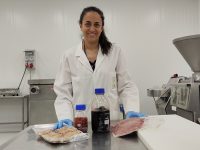 |
||
|
Biodiversity implies integral and sustainable development for it promotes competitiveness, growth and job creation and increases financial resources. The loss of biodiversity threatens our natural environment and thus, the quality of our life, representing a serious threat to our society and livelihoods. We arrived at Tamri at midday one April. Our aim was to photograph one of the most endangered species of birds of the Palaearctic, the Waldrapp or hermit ibis (Geronticus eremita). The sea cliff on which the colony was nested backed onto one of the most desolate places in Morocco. On a plain whipped by the harmattan, a dusty, dry wind, a type of subsistence agriculture had managed to establish some grain fields between dunes. Suddenly, a human figure emerged: «Je suis le gardien de l’ibis!». A young man was repeating this sentence in a French accent, easy to understand. And, if the language had not been clear, his gesture left no doubt about his intentions, he stretched his hand out, palm upturned, to receive financial compensation for parking in that place, although there was no other vehicle around. Although the access to the nesting area was strictly closed and guarded by watchmen, the surroundings were frequented by people who, like us, wanted to see the ibis. This had placed Timri on the map of birdwatchers, twitchers and a whole host of people from different backgrounds who were staying at the only hotel in the area. This young man had noted that the ibis had given jobs to many fellow citizens, caretakers of the colony, those working in the hotel and even in the bars where every night tagines were being served to visitors. And, of course, he wanted his share. It is undisputable that there is an increasing demand for leisure activities in nature, and wildlife observation is one of the most popular. In Europe many people are willing to travel to remote locations to observe a rare species, even for a few seconds. Many people may find it hard to believe, but such activities are becoming popular everywhere and can be a good engine for driving rural development if it is channelled well. However, this type of tourism is an activity that must be examined closely, as success can lead to depletion of the resources. And generally speaking these are resources of a very fragile nature. While the existence of a particular species can engender the articulation of a whole tourist industry in its surroundings, conservation and the exploitation of tourism need very strict game rules to be viable and for both to prosper mutually. We are not just talking about exotic travel. In Europe, in recent years, there have been projects for tourist development based on resources such as well preserved natural spaces or certain species of fauna. In many cases, even specific emblematic species have been reintroduced to increase the attractiveness of an area. Let us consider the example of the osprey in Scotland: it brings in 125,000 visitors annually and has an economic impact estimated at 3.2 million Euros per year. On the island of Mull alone the reintroduction of this species represents an income of 2.15 billion Euros a year! In a similar operation, Cevennes, a town dedicated primarily to the manufacture of cheese, has become the refuge of the vultures of the north side of the Pyrenees. Its «Museum of Vultures» attracts about 30,000 people every year and generates five jobs as a direct result. And the total flow of people attracted by the vultures in this corner of the Pyrenees is of 80,000 people, which translates into about 0.7 million Euros per year. A lesson to learn. In a neighbouring territory, Aragon, there coexists a rural countryside with problems of aging with lack of generational takeover and abandonment of farming, livestock and forestry, with a natural heritage that is becoming the basis of a growing tourism industry. No wonder, then, that it is the origin of the RETO (the acronym spelling «challenge») project –of the Spanish Network of Ornithological Tourism– or that in Lower Aragon there is, as example of the success of this new vision of natural resources, the Gallocanta Lake. Each winter thousands of cranes (Grus grus) congregate in this enclave where they find shelter and food. And to welcome them every October there is a hotel industry that hosts a party awaiting the arrival of the cranes. The main accommodation area is open only in the cranes’ wintering season and the 15,000 visitors a year make it difficult to find a place to sleep on the winter weekends in cold and windy environs, in principle unattractive to recreational visits. But the attraction of thousands of cranes flocking to spend the night on the lake makes it a perfect haven for those with a variety of tastes. And we could continue to expatiate with many other examples around the world, from diving in the Medes Islands to the orangutans of Sumatra; from the network of sanctuaries of the RSPB to the viewing of mountain gorillas in Uganda. But more important than the examples and accompanying visitors’ numbers is the common fact of their being located in remote places lacking a financial offer based on an industrial and agricultural infrastructure that happens not to be competitive. They are usually sited in areas away from major road networks and in many cases with serious depopulation problems. Arguably, this type of economic activity is not the single solution in view of a very long history of neglect and under-development of these areas; in few cases has nature tourism, by itself, produced a substantial change in the socioeconomics of any locality. That it is not manna sent from heaven, is evident. But it is also true that it is one of the alternatives that should help open new avenues for development, where it is still possible. We reveal nothing new when we say that the natural values harboured in many areas have often been accompanied by underdevelopment in infrastructure and lack of other public investments. Often when new policies are implemented to protect natural resources, whether they are named Nature 2000 network or natural parks, this is done across territories still rich in nature and forever poor in investment. You have to implement, therefore, compensation measures to offset losses that the new regulatory restrictions involve. From the urban world actions are often taken with little empathy for the traditional agents of biodiversity. In this sense, nature tourism still has a long way to go if it is to help improve economic development in many places. Furthermore, to make this happen, we need policies capable of devising a new model of economic development, free from the approach that has already devoured most of the land and now casts a hungry glance at what is left. |
© C. Santana
«There is a growing demand for nature leisure activities and wildlife observation is one of the most popular» |
|
Bibliography
Dickie, I., Hughes, J. & A. Esteban, 2006. Watched like never before-the local economic benefits of spectacular bird species. RSPB. Sandy.
Shiel, A., Rayment, M. & G. Burton, 2002. RSPB reserves and local economies. RSPB. Sandy.
UNEP/CMS Secretariat, 2006. Wildlife watching and tourism. UNEP. Bonn.





